
The Falklands War was a ten-week undeclared war between Argentina and the United Kingdom in 1982 over two British dependent territories in the South Atlantic: the Falkland Islands and its territorial dependency, South Georgia and the South Sandwich Islands. The conflict began on 2 April 1982, when Argentina invaded and occupied the Falkland Islands, followed by the invasion of South Georgia the next day. On 5 April, the British government dispatched a naval task force to engage the Argentine Navy and Air Force before making an amphibious assault on the islands. The conflict lasted 74 days and ended with an Argentine surrender on 14 June, returning the islands to British control. In total, 649 Argentine military personnel, 255 British military personnel, and three Falkland Islanders were killed during the hostilities.
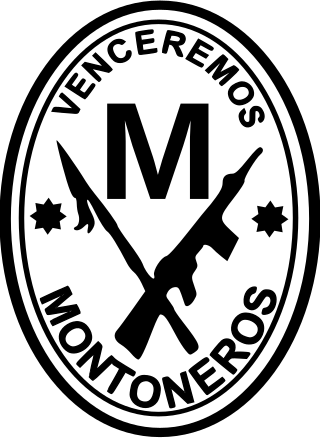
Montoneros was an Argentine far-left Peronist and Catholic revolutionary guerrilla organization, which emerged in the 1970s during the "Argentine Revolution" dictatorship. Its name was a reference to the 19th-century cavalry militias called Montoneras, which fought for the Federalist Party in the Argentine civil wars. Radicalized by the political repression of anti-Peronist regimes, the Cuban Revolution and socialist worker-priests committed to liberation theology, the Montoneros emerged from the 1960s Catholic revolutionary guerilla Comando Camilo Torres as a "national liberation movement", and became a convergence of revolutionary Peronism, Guevarism, and the revolutionary Catholicism of Juan García Elorrio shaped by Camilism. They fought for the return of Juan Perón to Argentina and the establishment of "Christian national socialism", based on 'indigenous' Argentinian and Catholic socialism, seen as the ultimate conclusion of Peronist doctrine.

A frogman is someone who is trained in scuba diving or swimming underwater in a tactical capacity that includes military, and in some European countries, police work. Such personnel are also known by the more formal names of combat diver, combatant diver, or combat swimmer. The word frogman first arose in the stage name the "Fearless Frogman" of Paul Boyton in the 1870s and later was claimed by John Spence, an enlisted member of the U.S. Navy and member of the OSS Maritime Unit, to have been applied to him while he was training in a green waterproof suit.
Algeciras is a municipality of Spain belonging to the province of Cádiz, Andalusia. Located in the southern end of the Iberian Peninsula, near the Strait of Gibraltar, it is the largest city on the Bay of Gibraltar.

Operation Flavius was a military operation in which three members of the Provisional Irish Republican Army (IRA) were shot dead by the British Special Air Service (SAS) in Gibraltar on 6 March 1988. The trio were believed to be planning a car bomb attack on British military personnel in Gibraltar. They were shot dead while leaving the territory, having parked a car. All three were found to be unarmed, and no bomb was discovered in the car, leading to accusations that the British government had conspired to murder them. An inquest in Gibraltar ruled that the authorities had acted lawfully but the European Court of Human Rights held that, although there had been no conspiracy, the planning and control of the operation was so flawed as to make the use of lethal force almost inevitable. The deaths were the first in a chain of violent events in a fourteen-day period. On 16 March, the funeral of the three IRA members was attacked, leaving three mourners dead. At the funeral of one, two British soldiers were killed after driving into the procession in error.

The People's Revolutionary Army was the military branch of the communist Workers' Revolutionary Party in Argentina.
The Battle of Two Sisters was an engagement of the Falklands War during the British advance towards the capital, Port Stanley. It took place from 11 to 12 June 1982 and was one of three battles in a Brigade-size operation all on the same night, the other two being the Battle of Mount Longdon and the Battle of Mount Harriet. It was fought mainly between an assaulting British force consisting of Royal Marines of 45 Commando and an Argentine Company drawn from 4th Infantry Regiment.
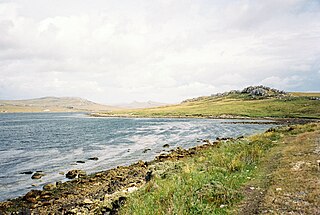
The Battle of Mount Tumbledown was an engagement during the Falklands War. The engagement was an attack by the British Army and the Royal Marines on the heights overlooking Stanley, the Falkland Islands capital. Mount Tumbledown, Mount William and Sapper Hill lie west of the capital. Due to their proximity to the capital, they were of strategic importance during the 1982 War. They were held by the Argentine 5th Naval Infantry Battalion, a reinforced, cold weather trained and equipped Marine battalion.
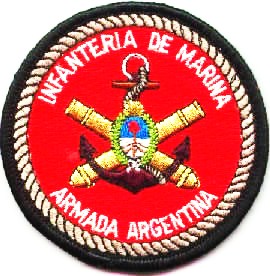
The 5th Marine Battalion is a battalion of the Argentine Marines.
ARA Santísima Trinidad is a Type 42 destroyer of the Argentine Navy, the only one of her class built outside Britain. She participated in the 1982 Falklands War. In January 2013 the ship capsized and sank at her moorings in the Argentine naval base of Puerto Belgrano due to lack of maintenance, being refloated in December 2015. The navy's plan to turn her into a museum ship was not realised and, in 2020, the Argentine president stated that the ship should be scrapped, though this was later blocked by federal courts.
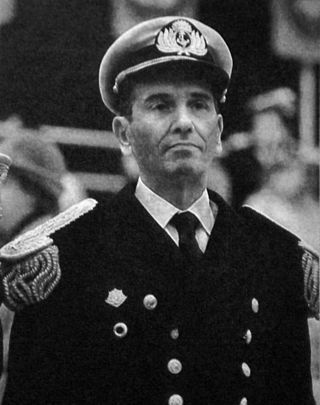
Admiral Jorge Isaac Anaya was an Argentine admiral and Commander-in-Chief of the Argentine Navy. He was born in Bahía Blanca, in the province of Buenos Aires. He participated in the right-wing military dictatorship known as the National Reorganisation Process (1976–1983) and, along with Leopoldo Fortunato Galtieri and Basilio Lami Dozo, was a member of the Third Military Junta that ruled Argentina between 1981 and 1982. He was the main architect and supporter of a military solution for the long-standing claim over the Falkland Islands that led to the Falklands War.
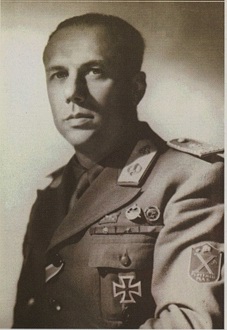
The Decima Flottiglia MAS was an Italian flotilla, with marines and commando frogman unit, of the Regia Marina created during the Fascist regime.
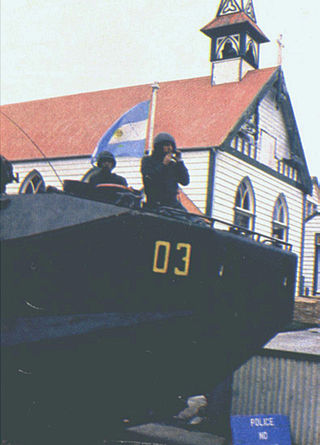
The Invasion of the Falkland Islands, code-named Operation Rosario, was a military operation launched by Argentine forces on 2 April 1982, to capture the Falkland Islands, and served as a catalyst for the subsequent Falklands War. The Argentines mounted amphibious landings and the invasion ended with the surrender of Falkland Government House.
This is a list of the ground forces from Argentina that took part in the Falklands War. For a list of ground forces from the United Kingdom, see British ground forces in the Falklands War.

Operation Paraquet was the code name for the British military operation to recapture the island of South Georgia from Argentine military control in April 1982 at the start of the Falklands War.
There were many events leading to the 1982 Falklands War between the United Kingdom and Argentina over possession of the Falkland Islands and South Georgia.

Operativo Independencia was a 1975 Argentine military operation in Tucumán Province to crush the People's Revolutionary Army (ERP), a Guevarist guerrilla group which tried to create a Vietnam-style war front in the northwestern province. It was the first large-scale military operation of the Dirty War.

The military history of Gibraltar during World War II exemplifies Gibraltar's position as a British fortress since the early 18th century and as a vital factor in British military strategy, both as a foothold on the continent of Europe, and as a bastion of British sea power. During World War II, Gibraltar served a vital role in both the Atlantic Theatre and the Mediterranean Theatre, controlling virtually all naval traffic into and out of the Mediterranean Sea from the Atlantic Ocean.

The auxiliary ship Olterra was a 5,000 ton Italian tanker scuttled by her own crew at Algeciras in the Bay of Gibraltar on 10 June 1940, after the entry of Italy in World War II. She was recovered in 1942 by a special unit of the Decima Flottiglia MAS to be used as an undercover base for manned torpedoes in order to attack Allied shipping at Gibraltar.

The attack on USNS Card was a Viet Cong (VC) operation during the Vietnam War. It took place in the port of Saigon in the early hours of 2 May 1964, and was mounted by commandos from the 65th Special Operations Group.
















